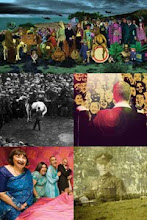The next speaker at the Shift Happens event was Artistic Director of the Pilot Theatre, Marcus Romer. We have been lucky enough to work with Pilot on a couple of co-productions (Beautiful Thing and East is East) and it seems Pilot have really embraced the whole Web 2.0 age, so much so that I don't even have to give you the low down on his talk. You can read it here, plus there are some really nice bits and pieces on their site such as short little video guides to social networking, wikis, blogs and things of that ilk. They are fun and also remove much of the mystique about web phenomena and applications. Have a look here, here and here. You can even see a video demo of Pilot Theatre in Second Life! Fancy....
Next up was Roma Patel. Roma is a Scenographer and Digital Artist and has embraced the opportunities offered via new technology with her work in Theatre Design with some great results. Not only does she use new technology herself, she has also researched the impact of utilising this new technology amongst her peers.
I will admit to having rather a soft spot for the 'old skool' small scale models of sets that theatre designers use, there is something so touchly-feely about them and I love seeing things in miniature, plus the beautiful costume sketches designers produce are little works of art. It was the same when I worked in advertising, I loved the hand-drawn black and white 'scamps' the creatives used to convey a concept or idea as they allowed the imagination to flow and the idea to be discussed without distractions about what colour the headline would be or what image we would use in that space. However, not everyone could see an idea from a hand drawn outline and as more and more 'creatives' became conversant with Macs and thus Mac visuals, it seemed as if the focus of discussions moved away from whether this was a good concept to if blue or purple would be the best colour for the headline. Shame!
Anyway, I digress but I can see how the beauty of harnessing digital technology has started to provide more freedom for theatre designers and also allowed a practical solution to many problems, particularly when it comes to designing for tours that require a set to be adaptable to various different spaces. Imagine the scenario...
Production manager: But the ceiling is lower at our a venue, not sure it will fit. Can you build me a new model to check the scale!!
Designer No, problem, no need for a new model, let's see if the set still fits. [Tappity tap, adjust scale button (?!)] There you go, it fits no problem.
Or how about:
Director: I want the atmosphere to be more dramatic, more moody, more ominous, perhaps we need to re-paint the set (I am sure Director's say things just like that, don't they??)
Lighting Designer: Hmm [Tappity tap, adjust lighting with Apple, control adjust lighting key or something] Is that the kind of thing you want?
Director: [Looking at screen] Perfect
Lighting Designer: We'll just need some new gels and to re-set the light at a different height to change the shadowing....
Hope you get the idea. Apologies lighting designers/directors/production managers I have no idea how it the production side works but can see how computers might add a flexible new dimension to the design process. An opportunity to trial, adjust and test before we go to the build stage.
The thing that struck me most about Roma's talk was the overview she gave of Cork's Capital of Culture production (2005) of The Merchant of Venice! In large part due to her ability to be able to recreate the town in 3-D on her computer they were able to have different scenes of the production taking place at different venues throughout Cork town with the audiences being guided between the venues / scenes by musicians and placard wavers. It allowed them to take advantage of some impressive locations while at the same time showing visitors some of the beautiful architecture in the town. The court scenes took place in the court (of course), Belmont scenes were inside various warehouses and Venice scenes out on the street and the wedding / Shylock's conversion to Christianity where else but in the Church. You can see some of the images from the production (both real and digital) here. Unfortunately, you can't see the computer generated walk through of the town which was quite startling.
So thank you Roma and Marcus, all really good stuff....
Friday 18 July 2008
Subscribe to:
Post Comments (Atom)





0 comments:
Post a Comment